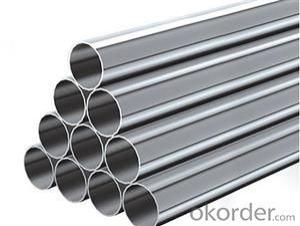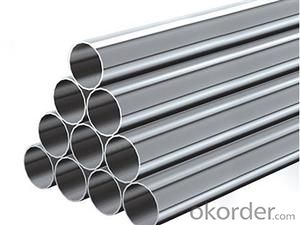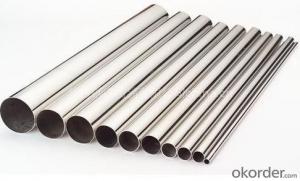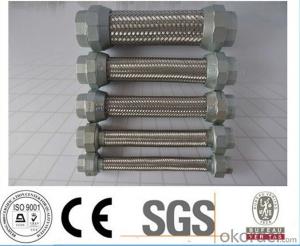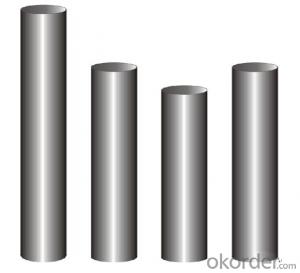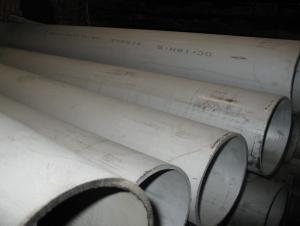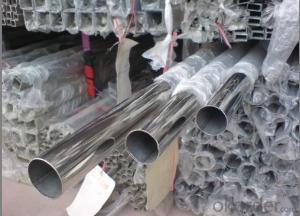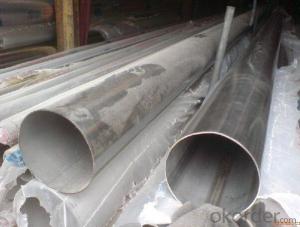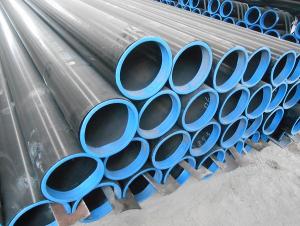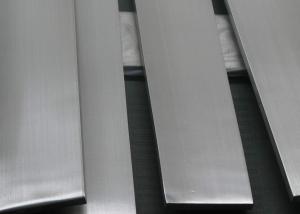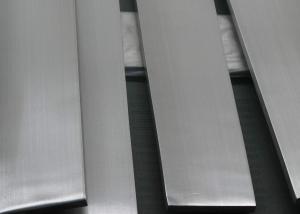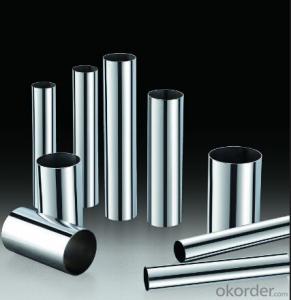Oil Gas Sewage Transport Usage Hot Rolled Stainless Steel Pipe
- Loading Port:
- Tianjin
- Payment Terms:
- TT OR LC
- Min Order Qty:
- 35 m.t.
- Supply Capability:
- 5000 m.t./month
OKorder Service Pledge
OKorder Financial Service
You Might Also Like
Specification
1.Structure of Hot Rolled Stainless Steel Pipe:
Seamless pipe is formed by drawing a solid billet over a piercing rod to create the hollow shell. As the manufacturing process does not include any welding, seamless pipes are perceived to be stronger and more reliable. Historically seamless pipe was regarded as withstanding pressure better than other types, and was often more easily available than welded pipe.
2.Main Features of the Hot Rolled Stainless Steel Pipe:
• High manufacturing accuracy
• High strength
• Small inertia resistance
• Strong heat dissipation ability
• Good visual effect
• Reasonable price
3.Hot Rolled Stainless Steel PipeSpecification:
Standard | GB, DIN, ASTM ASTM A106-2006, ASTM A53-2007 |
Grade | 10#-45#, 16Mn 10#, 20#, 45#, 16Mn |
Thickness | 8 - 33 mm |
Section Shape | Round |
Outer Diameter | 133 - 219 mm |
Place of Origin | Shandong, China (Mainland) |
Secondary Or Not | Non-secondary |
Application | Hydraulic Pipe |
Technique | Cold Drawn |
Certification | API |
Surface Treatment | factory state or painted black |
Special Pipe | API Pipe |
Alloy Or Not | Non-alloy |
Length | 5-12M |
Outer Diameter | 21.3-610mm |
Grade | 20#, 45#, Q345, API J55, API K55, API L80, API N80, API P110, A53B |
Standard | ASME, ASTM |
1) Material:20#(ASTM A 106/A53 GRB.API5LGRB,GB),45#,16Mn,10#.
2) Specification range:OD:21.3-610mm,WT:6-70mm,length:6-12m or according to the requirement of clients.
3) Excutive standards:GB,ASME API5L.ASTM A 106/A53,Despite of the above standards,we can also supply seamless steel pipe with standard of DIN,JIS,and so on,and also develop new products according to the requirements of our clients!
4) Surface:black lacquered,varnish coating or galvanized.
5) Ends:Beveled or square cut,plastic capped,painted.
6) Packing:bundles wrapped with strong steel strip,seaworthy packing.
4.Packaging & Delivery
Packaging Details: | seaworthy package,bundles wrapped with strong steel strip |
Delivery Detail: | 50-60days after received 30%TT or Original LC |
5.FAQ of Hot Rolled Stainless Steel Pipe:
How is the quality of your products?
Our products are manufactured strictly according to national and internaional standard, and we take a test on every pipe before delivered out. If you want see our quality certifications and all kinds of testing report, please just ask us for it.
Guaranteed: If products’ quality don’t accord to discription as we give or the promise before you place order, we promise 100% refund.
②How about price?
Yes, we are factory and be able to give you lowest price below market one, and we have a policy that “ for saving time and absolutely honest business attitude, we quote as lowest as possible for any customer, and discount can be given according to quantity”,if you like bargain and factory price is not low enough as you think, just don’t waste your time.Please trust the quotation we would give you, it is professional one.
③Why should you chose us?
Chose happens because of quality, then price, We can give you both.Additionally, we can also offer professional products inquiry, products knowledge train(for agents), smooth goods delivery, exellent customer solution proposals.Our service formula: good quality+good price+good service=customer’s trust
SGS test is available, customer inspection before shipping is welcome, third party inspection is no problem.
Any question, pls feel free to contact us !
6.Hot Rolled Stainless Steel Pipe Images:
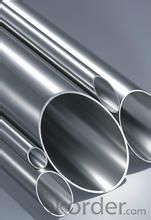
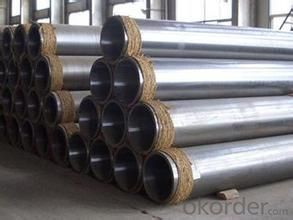
7. Company Information:
CNBM International Corporation (CNBM International) is the most important trading platform of CNBM Group Corporation, a state-owned company under the direct supervision of State-owned Assets Supervision and Administration Commission of the State Council.
Since 2004, the trading volume of CNBM International has been doubled in 5 successive years owing to the support of superior corporations and effort of all staff. Meanwhile, we have established strategic partnerships with hundreds of domestic manufacturers and sound business relations with clients from over 120 countries. Currently, we have wholly-owned overseas subsidiaries and branches in 5 countries with a view to realize localization, which also represents an essential progress in our globalization target.
In line with the business, CNBM International launched E-business platform Okorder.com.Our goal is to transform CNBM International into the global leading brand in building materials industry within 3 to 5 years through innovation and reform, by strengthening the overall management of supply chain, developing and cultivating both domestic and overseas market, improving the procedure and information system, enhancing the ability to organize resources and to provide value-added services under a professional team and a learning organization.
- Q: What is stainless steel pipe?
- Stainless steel pipes, crafted from a steel and chromium alloy, boast exceptional resistance to corrosion and oxidation. Their durability, strength, and aesthetic appeal make them a popular choice across industries like construction, automotive, and manufacturing. These pipes have the ability to withstand high temperatures and pressure, making them ideal for fluid and gas transportation. Moreover, they come in a range of sizes, shapes, and grades to cater to individual needs. Whether in residential or industrial settings, stainless steel pipes find extensive use in plumbing, water supply systems, HVAC systems, and various other applications where durability and corrosion resistance are paramount.
- Q: How do you prevent clogging in stainless steel pipes?
- There are several steps that can be taken to prevent clogging in stainless steel pipes: 1. Regular maintenance is crucial. It is important to regularly inspect and clean the pipes to remove any build-up or debris that could cause blockages. 2. Proper waste disposal is essential. Only dispose of appropriate materials in the pipes and avoid flushing items like paper towels, sanitary products, or grease down the drain. These can accumulate and lead to clogs. 3. Install drain filters or strainers. These can catch large particles or debris that may cause clogs. Clean or replace them as needed. 4. Avoid corrosive materials. Certain chemicals or substances can corrode stainless steel pipes, leading to damage and potential clogs. Follow manufacturer guidelines and avoid using corrosive materials near the pipes. 5. Ensure proper water flow. Run water regularly, especially in pipes that are not frequently used, to maintain adequate water flow and prevent clogs. 6. Consider using water softeners. If your water supply is hard and contains minerals that can build up, installing a water softener can reduce mineral deposits and prevent clogs. 7. Seek professional assistance if needed. If you experience persistent clogging or are unsure about prevention methods, consult with a professional plumber. They can assess the situation, provide guidance, and effectively address any existing clogs. By following these preventive measures, you can minimize the risk of clogs in stainless steel pipes and maintain the efficient operation of your plumbing system.
- Q: What is the difference between 2205 and 2507 stainless steel pipes?
- The main difference between 2205 and 2507 stainless steel pipes lies in their chemical composition and corrosion resistance. While both are duplex stainless steels, 2205 contains 22% chromium, 5% nickel, and 3% molybdenum, whereas 2507 contains 25% chromium, 7% nickel, and 4% molybdenum. This difference in composition provides 2507 with slightly higher corrosion resistance, especially in environments with high levels of chloride ions. Additionally, 2507 stainless steel pipes offer better strength and impact toughness compared to 2205. Consequently, 2507 is often chosen for applications that require enhanced resistance to corrosion and higher strength.
- Q: Ask experts, 304 stainless steel pipe why rust?
- Stainless steel is not easy to rust and has a lot to do with the composition of stainless steel. In addition to iron, stainless steel contains chromium, nickel, aluminum, silicon and so on. General stainless steel chromium content is generally not less than 12%, high even up to 18%. Steel added elements such as chromium, can change the performance of the steel, such as the molecular structure of steel more uniform on the surface of the steel is more easily to form a layer of dense oxide protective film, thereby greatly improving the ability of corrosion-resistant stainless steel. Therefore, stainless steel can resist fire, water, acid, alkali and various solutions to its corrosion, not rust. The scientists found that the internal structure of the steel is more uniform, various components more closely linked to the corrosion of the more difficult the invasion, also attached to the surface with a layer of oxide film, like iron and steel to wear armor, was not naturally easy to rust.
- Q: What is the difference between stainless steel pipes and PVC pipes?
- Stainless steel pipes are made from a durable and corrosion-resistant material, while PVC pipes are made from a lightweight and cost-effective plastic. Stainless steel pipes are suitable for high-pressure and high-temperature applications, while PVC pipes are commonly used for water supply and drainage systems. Additionally, stainless steel pipes have a longer lifespan and can withstand harsh environmental conditions, whereas PVC pipes may degrade over time and are more prone to cracking or breaking.
- Q: How do stainless steel pipes compare to other materials like copper or PVC?
- Stainless steel pipes have several advantages over other materials such as copper or PVC. Firstly, stainless steel is highly resistant to corrosion and rust, making it suitable for various applications, especially in environments with high moisture or chemical exposure. Copper pipes, on the other hand, are susceptible to corrosion over time and may require additional protective coatings or treatments. Secondly, stainless steel pipes have excellent strength and durability, allowing them to withstand high pressure and temperature conditions. PVC pipes, although lightweight and easy to install, are not as strong as stainless steel and may crack or deform under extreme conditions. Another advantage of stainless steel pipes is their ability to handle a wide range of fluids, including corrosive substances and high-temperature liquids. PVC pipes, in contrast, are limited in their compatibility and may not be suitable for certain applications that require resistance to chemicals or extreme temperatures. Furthermore, stainless steel pipes offer superior fire resistance compared to PVC pipes, which are highly flammable and release toxic fumes when exposed to fire. This makes stainless steel pipes a safer option, especially in buildings or industries where fire safety is crucial. Lastly, stainless steel pipes have a longer lifespan compared to copper or PVC pipes. While copper pipes may develop leaks or pinholes over time, and PVC pipes may become brittle and crack, stainless steel pipes are designed to last for decades with minimal maintenance. In summary, stainless steel pipes are a reliable and durable choice for various applications due to their corrosion resistance, strength, versatility, fire resistance, and long lifespan. They outperform copper and PVC pipes in terms of durability, compatibility, safety, and overall performance, making them an excellent choice for a wide range of industries and applications.
- Q: How do stainless steel pipes compare to carbon fiber pipes?
- Stainless steel pipes and carbon fiber pipes have their own unique characteristics and are used in different applications. Stainless steel pipes are known for their durability and strength. They are highly resistant to corrosion and can withstand high temperatures and pressures. This makes them suitable for various industries such as oil and gas, chemical, and construction. Stainless steel pipes have a longer lifespan and can handle heavy loads, making them a reliable choice for many applications. However, stainless steel pipes are relatively heavy and may require additional support structures. On the other hand, carbon fiber pipes are lightweight and have a high strength-to-weight ratio. They are made from carbon fibers embedded in a resin matrix, resulting in a strong and rigid material. Carbon fiber pipes are commonly used in industries such as aerospace, automotive, and sports equipment. The lightweight nature of carbon fiber pipes allows for increased fuel efficiency in vehicles and improved performance in sports equipment. However, carbon fiber pipes are more expensive than stainless steel pipes and may not be as resistant to extreme temperatures or corrosive environments. In summary, stainless steel pipes are known for their durability and resistance to corrosion, making them suitable for heavy-duty applications. Carbon fiber pipes, on the other hand, are lightweight and offer high strength-to-weight ratio, making them ideal for applications where weight reduction is critical. The choice between stainless steel and carbon fiber pipes ultimately depends on the specific requirements of the application and the trade-offs between cost, weight, and performance.
- Q: What is the difference between seamless and EFW stainless steel pipes?
- Seamless and EFW (Electric Fusion Welded) stainless steel pipes are two different types of stainless steel pipes that have distinct characteristics and manufacturing processes. Firstly, seamless stainless steel pipes are manufactured without any welding seams or joints. They are made from a solid cylindrical billet, which is heated and then stretched over a mandrel to create a hollow tube. This process ensures that seamless pipes have a consistent wall thickness and a smooth interior surface, making them ideal for applications that require high-pressure, high-temperature, or corrosive environments. Due to their seamless construction, these pipes offer better strength and durability. On the other hand, EFW stainless steel pipes are created by using a combination of high-frequency electrical current and pressure to weld the edges of two stainless steel sheets or plates together. This fusion welding process forms a continuous seam along the length of the pipe. EFW pipes are typically used for lower-pressure and lower-temperature applications, such as conveying fluids or gases in industrial settings. One key difference between seamless and EFW stainless steel pipes is their manufacturing complexity. Seamless pipes require more intricate and precise manufacturing techniques, resulting in a higher production cost compared to EFW pipes. Additionally, the seamless process allows for a wider range of sizes and thicknesses, while EFW pipes are typically limited in their size options. Another difference lies in the availability of grades and alloys. Seamless stainless steel pipes are available in a wide range of grades and alloys, offering greater flexibility for specific applications. EFW pipes, on the other hand, have a more limited selection of available grades and alloys. In terms of mechanical properties, seamless stainless steel pipes generally have superior strength and corrosion resistance compared to EFW pipes. The absence of welds or joints in seamless pipes reduces the risk of weak points that could be prone to corrosion or failure. In summary, seamless stainless steel pipes are manufactured without any welding seams, offering better strength, durability, and corrosion resistance. They are suitable for high-pressure, high-temperature, or corrosive applications. EFW stainless steel pipes, on the other hand, are created by fusion welding two stainless steel sheets or plates together, making them more suitable for lower-pressure and lower-temperature applications.
- Q: Can stainless steel pipes handle acidic or alkaline fluids?
- Stainless steel pipes possess the ability to accommodate both acidic and alkaline fluids. Their exceptional corrosion resistance, a renowned attribute of stainless steel, renders them highly suitable for managing aggressive substances. This notable quality stems from the presence of chromium, which interacts with oxygen and generates a thin protective layer on the steel's surface, effectively halting further corrosion. This passive layer remains steadfast in both acidic and alkaline environments, furnishing long-lasting protection against corrosive fluids. However, the level of corrosion resistance may fluctuate depending on the specific stainless steel grade employed, as well as the fluid's concentration and temperature during transport. Consequently, it becomes crucial to meticulously select the appropriate stainless steel grade and duly consider factors like temperature, concentration, and potential exposure to other corrosive substances when opting for stainless steel pipes for the handling of acidic or alkaline fluids.
- Q: Are stainless steel pipes suitable for high-pressure steam applications?
- Yes, stainless steel pipes are suitable for high-pressure steam applications. Stainless steel has excellent corrosion resistance, high-temperature strength, and durability, making it a suitable material choice for handling high-pressure steam.
Send your message to us
Oil Gas Sewage Transport Usage Hot Rolled Stainless Steel Pipe
- Loading Port:
- Tianjin
- Payment Terms:
- TT OR LC
- Min Order Qty:
- 35 m.t.
- Supply Capability:
- 5000 m.t./month
OKorder Service Pledge
OKorder Financial Service
Similar products
Hot products
Hot Searches
Related keywords
